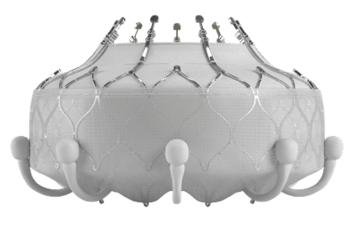Edwards EVOQUE Tricuspid Valve Replacement System – P230013
This is a brief overview of information related to FDA’s approval to market this product. See the links below to the Summary of Safety and Effectiveness Data (SSED) and product labeling for more complete information on this product, its indications for use, and the basis for FDA’s approval.
Product Name: Edwards EVOQUE Tricuspid Valve Replacement System
PMA Applicant: Edwards Lifesciences LLC
Address: One Edwards Way, Irvine, CA 92614
Approval Date: February 01, 2024
Approval Letter: Approval Order
What is it?
The Edwards EVOQUE Tricuspid Valve Replacement System mainly includes an artificial tricuspid valve (called the EVOQUE valve) and a delivery catheter. The EVOQUE valve is made of cow tissue attached to a self-expanding metal (nickel-titanium) frame for support. It can be used to replace the tricuspid valve of the heart without open-heart surgery. The tricuspid valve prevents backflow of blood into the right atrium (upper right chamber of the heart) from the right ventricle (lower right chamber of the heart).
How does it work?
The doctor compresses the EVOQUE valve and places it on the end of the delivery catheter. The doctor then inserts the catheter with the attached valve through the largest vein (femoral vein) in the groin area and pushes it through the blood vessels until it reaches the diseased tricuspid valve. The doctor then releases the valve from the catheter. The valve will expand to anchor within the patient’s diseased valve. Finally, the doctor removes the delivery catheter from the body. Once the new valve is in place, it functions the same as the old valve, opening and closing like a door to force the blood to flow in the correct direction within the heart.
When is it used?
The EVOQUE valve is intended to treat patients with severely leaky tricuspid valve (tricuspid regurgitation) often caused by an enlarged heart or damaged native valve flaps (called leaflets).
What will it accomplish?
The EVOQUE valve could reduce the amount of blood that moves in the wrong direction through the tricuspid valve. As a result, the patient may have:
- improved quality of life
- relief of symptoms such as tiredness or fatigue
- improved ability to exercise
A clinical study compared the results of 96 patients treated with the EVOQUE valve and medicine, and 54 patients treated only with medicine. The study showed:
- About 28% (28 out of 100) patients treated with the EVOQUE valve experienced a major safety complication (for example, death from heart-related cause, need for permanent pacemaker, or severe bleeding) within 30 days of the procedure.
- About 99% (99 out of 100) of the patients treated with the EVOQUE valve had their severe valve leakage reduced to moderate or less compared to about 22% (22 out of 100) of the patients treated with medicine alone.
- Patients who received an EVOQUE valve were about five times more likely to have an improved quality of life, fewer symptoms (for example, shortness of breath and fatigue), and improved ability to exercise six months after the procedure, than patients treated with medicine alone.
When should it not be used?
The EVOQUE system should not be used in patients who:
- Cannot tolerate certain blood thinners during or after the procedure
- Have an untreatable allergy to nickel or titanium
- Have an active infection in the heart or elsewhere in the body
Additional information (including warnings, precautions, and adverse events):
- Summary of Safety and Effectiveness Data (SSED)
- Labeling – Instructions For Use
- Labeling Part 2 – Patient Information
- PMA Database entry

